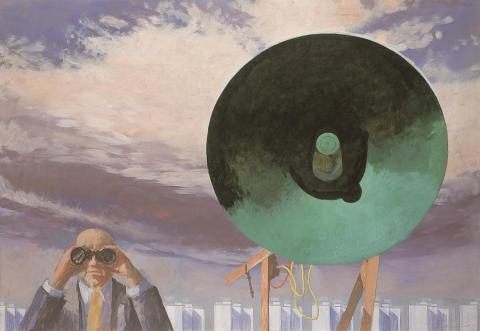SINOPIA FOR THE OBSERVER, 1983
JEFFREY SMART
oil and synthetic polymer paint on paper on canvas
101.0 x 145.0 cm
signed lower right: Jeffrey Smart
Australian Galleries, Sydney (label attached verso)
Private collection, Sydney
Deutscher~Menzies, Melbourne, 9 May 2001, lot 15
Private collection, Sydney
McDonald, J., Jeffrey Smart: Paintings of the '70s and '80s, Craftsman House, Sydney, 1990, pp. 32–33
Smart, J., et al., Jeffrey Smart Drawings and Studies 1942–2001, Australian Galleries, Melbourne, 2001, pp. 120–121
The Observer I, 1983, synthetic polymer paint and oil on fibreglass canvas, 100.0 x 144.0 cm, and Study for The Observer I, 1983, synthetic polymer paint and oil on fibreglass canvas, 30.0 x 44.0 cm, were exhibited in Jeffrey Smart: Recent Paintings, Australian Galleries, Melbourne, 22 March – 9 April 1983, cat. 4 (cover illustration) and 17 respectively
The Observer II, 1983–84, synthetic polymer paint and oil on canvas, 100.0 x 70.0 cm, private collection, illus. in Pearce, B., Jeffrey Smart, Beagle Press, Sydney, 2005, p. 176
'I don't want to paint my personal scream - I prefer to stay detached ...'1
Sinopia for The Observer, 1983 is a rare and special work in Jeffrey Smart's oeuvre. He kept it for a long time in his personal collection. As the primary painting for his several versions of 'The Observer', the addition of the word 'sinopia' to the title suggests that Smart saw it as a fully developed work in its own right, but with a special purpose. From Roman to Renaissance times, the term'sinopia' in fresco painting referred to the full-scale red under-drawing on the penultimate layer of plaster, usually of striking spontaneity and freedom in its difference from the final painting. Freedom of execution and spontaneity are exactly what characterise Smart's Sinopia for The Observer. The later The Observer I, 1983 is more finished in appearance. Almost identical in size, it too has the figure to the left of the loudspeaker. Observer II, 1983-84 is smaller in size, the figure now on the right, with an enlarged all-seeing eye in one of the lenses of the binoculars.
They were painted leading up to and during 1984, each troubling in its own special way, arousing thoughts of George Orwell's book, Nineteen Eighty-Four and the constant reminder that 'Big Brother is watching you'.2 The spying binoculars and attendant loudspeaker of broadcast dictation is so pertinent to our times of surveillance and intrusion. As John McDonald observed, 'Even if we discard such implications, the man's binoculars and his proximity to the public address system put him implicitly in a position of power over those whom we assume he is observing.'3
Smart was ever the master of the enigmatic, so a different, though not unallied interpretation of this work is allowable. It could be seen simply as a caller at a racetrack; but that is too straight-forward and lacking the drama of one who observed the human race rather than that of horses. Given the vague resemblance to Smart, it is more likely to be the artist himself, the anonymous observer.
Viewing the world at arm's length from an elevated position, the loud speaker is not only an actual means of communication but also a metaphor of his painting. Jeffrey Smart was a classicist in contemporary guise. In the Renaissance and other times artists often appeared in their own pictures attired in the styles and within the settings of their age, as one recalls Johannes Vermeer's masterpiece, The Art of Painting in Vienna.4 Smart once wrote, 'I don't want to be a Dufy, I want to be a Vermeer.'5 Ever balancing detachment with the paradox of involvement, Smart wore the mask of personality in his art more than in his person.6 Disguise was his forte as he soliloquized on the stage of his paintings. Vale Jeffrey!
1. Smart, J., et al., Jeffrey Smart Drawings and Studies 1942-2001, Australian Galleries, Melbourne, 2001, p. 121
2. Orwell, G., Nineteen Eighty-Four, Secker and Warburg, London, 1949, part 1, chapter 1
3. McDonald, J., Jeffrey Smart: Paintings of the'70s and'80s, Craftsman House, Sydney, 1990, p. 33
4. Johannes Vermeer van Delft (1632-75, The Netherlands), Die Malkunst (The Art of Painting), c1666-68, Kunsthistorisches Museum, Vienna
5. Quoted in Pearce, B., Jeffrey Smart, Beagle Press, Sydney, 2005, p. 189
6. The word 'persona' in Latin means mask, derived from a theatrical mask and the character played by an actor.
DAVID THOMAS
